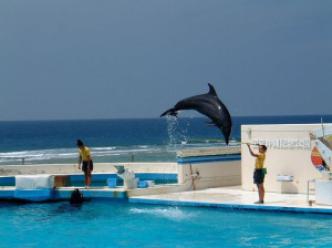 The first seed of my sabbatical came at the Loose Moose Theater Company’s International Improvisation Summer School two years ago in Calgary, Alberta. One of our teachers, Shawn Kinley, introduced the Dolphin Game and my heart leapt. Two of my favorite things–improv and positive reinforcement–in one exercise? Whiskers on kittens!
The first seed of my sabbatical came at the Loose Moose Theater Company’s International Improvisation Summer School two years ago in Calgary, Alberta. One of our teachers, Shawn Kinley, introduced the Dolphin Game and my heart leapt. Two of my favorite things–improv and positive reinforcement–in one exercise? Whiskers on kittens!
The directions were deceptively simple. One person, our “dolphin,” would leave the room. The remaining audience would serve as “trainer,” guiding the dolphin to whatever action we chose, using the central principle of positive reinforcement: reward movement toward the behavior you seek and ignore the rest. Whether we wanted a jumping jack or seated lotus position, whenever the dolphin moved in that direction, we were to offer a simple, emotion-free “ding.” When the dolphin veered away from the chosen task, we were to remain silent.
Breathtakingly–and hilariously–the training worked wonders when our volunteer returned to the stage. We started with small, simple tasks but quickly got more complex, asking our dolphins to speak or dance or perform sequences of movements. We worked with two trainers and two dolphins in one on-stage “tank” and then moved to multiple learners seeking one coordinated task. The possibilities and potential lessons seemed endless. Anyone could learn any behavior–and the process of getting there was a blast along the way.
When I got back home, I soon took the exercise elsewhere, playing with anyone game enough–or kind enough–to indulge me. My students howled at being led to “swim” under desks. My family delighted at Thanksgiving when my sister got it that she needed to sing. And colleagues perked noticeably when I brought the game to our faculty meeting or to a conference session for the Applied Improvisation Network. Though the journeys sometimes proved challenging–maybe because they often did–reaching the goal inevitably elicited a roar of success.
Perhaps surprisingly, some of the game’s greatest delights come when the dolphin makes a sincere “error.” Take last year when I was invited to lead an all-school assembly at Phillips Exeter Academy, for example. The 1000+ members of the student body had decided to train a classmate to “Tebow”‘, that one-knee, fist-to-forehead gesture of prayerful gratitude made famous by an NFL quarterback. The student dolphin worked his way toward success, causing an anticipatory stir when he got down on one knee (this group had a tough time maintaining silence around the ‘ding’s). When he then plaintively turned to the audience and spoke out “Will you marry me?”, the place erupted in heartfelt laughter. The dolphin was “wrong” in one sense, but had found something even better. And, yes, he did eventually Tebow.
I’ve also seen variations on the exercise that mix in “punishment” of sorts, indicating “warmer” as the dolphin approaches the behavior and “colder” as it moves away. One improv group I’ve played with recently uses the game to get the audience involved and energized, asking them to vary their volume when singing a familiar song like Happy Birthday or Old McDonald. Volunteer moves closer to the task? Sing louder. Further away? Quiet down. Both gradated versions remain entertaining and, like the original, almost always end in a shared feeling of success. Because they make it more convenient for the “trainers”, however, these forms actually cloud some of the available lessons about teaching and learning.1
With the simpler form, lessons stay consistently clear and students of all ages can draw from the insights. For example, clarity of intention matters: the trainer needs to know and name the specific behavior she’s looking for. The timing of the feedback matters immensely. The dolphin can’t find what’s “right” without risking what’s “wrong.” Teachers and learners respond differently to challenge: some shrink to paralysis while others rise to even greater determination. It’s almost impossible at first to resist saying “no” when the dolphin goes of course. The list goes on.
When kids (and adults) get the chance to find these truths for themselves, they reshape how they go about their own teaching and learning. They take more ownership and, dare I say, become a bit sassier in asking for what they need. They also take pride in helping each other learn: I regularly hear “ding”s for desirable behaviors long after we’ve done the exercise. They understand *experientially* in a way that talking can’t approach. Everyone wants to try being the dolphin. Everyone wants to learn.
Click here for Part 2: If the Dolphin Training game shows us how much fun–and success–we can have when learning by positive reinforcement methods, why do so few teachers of improv use the approach?



[…] ← Dolphin Training (part 1 of 2) This is General Tom […]